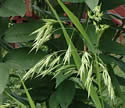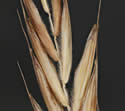Bromus latiglumis (Earlyleaf Brome)
| Also known as: | Ear-leaved Brome, Broad-glumed Brome, Flanged Brome |
|---|---|
| Genus: | Bromus |
| Family: | Poaceae (Grass) |
| Life cycle: | perennial |
| Origin: | native |
| Habitat: | part shade, shade, sun; average to moist; floodplain forest, deciduous woods, wooded shores, river banks, |
| Fruiting season: | August - September |
| Plant height: | 30 to 60 inches |
| Wetland Indicator Status: | GP: FACW MW: FACW NCNE: FACW |
| MN county distribution (click map to enlarge): |  |
| National distribution (click map to enlarge): |  |
Pick an image for a larger view. See the glossary for icon descriptions.
Detailed Information
Flower: 

![[photo of panicles]](/udata/r9ndp23q/pd3/bromus-latiglumis-072317-5-t.jpg) Flowering head is an open panicle 4 to 8 inches long, nodding to one side, the branches arching, drooping at the tips with 2 or more spikelets (flower clusters) per branch. Spikelets are stalked, oblong-elliptic in outline, slightly flattened, 15 to 25+ mm (to 1+ inch) long, with 4 to 9 fertile florets. One or more sterile florets may be at the tip.
Flowering head is an open panicle 4 to 8 inches long, nodding to one side, the branches arching, drooping at the tips with 2 or more spikelets (flower clusters) per branch. Spikelets are stalked, oblong-elliptic in outline, slightly flattened, 15 to 25+ mm (to 1+ inch) long, with 4 to 9 fertile florets. One or more sterile florets may be at the tip.
![[close-up of spikelet]](/udata/r9ndp23q/pd3/bromus-latiglumis-8151-2-t.jpg) At the base of a spikelet is a pair of bracts (glumes), both usually hairy, pointed at the tip, the lower glume 4.5 to 7.5 mm long and 1-veined (rarely with faint lateral veins), the upper glume 6 to 9 mm long and 3 to 5-veined. Surrounding a floret is a pair of bracts (lemma and palea). Lemmas are lance-elliptic, papery, 8 to 14 mm long, 5 to 7-veined, notched at the tip forming 2 teeth, a straight awn 3 to 5 mm long arising between the teeth, and the lemma body usually sparsely to moderately short-hairy on the surface with longer hairs along the edges especially on the lower half. The palea is somewhat shorter than the lemma, 2-veined and hairy along the veins. Sterile florets are like the fertile but underdeveloped.
At the base of a spikelet is a pair of bracts (glumes), both usually hairy, pointed at the tip, the lower glume 4.5 to 7.5 mm long and 1-veined (rarely with faint lateral veins), the upper glume 6 to 9 mm long and 3 to 5-veined. Surrounding a floret is a pair of bracts (lemma and palea). Lemmas are lance-elliptic, papery, 8 to 14 mm long, 5 to 7-veined, notched at the tip forming 2 teeth, a straight awn 3 to 5 mm long arising between the teeth, and the lemma body usually sparsely to moderately short-hairy on the surface with longer hairs along the edges especially on the lower half. The palea is somewhat shorter than the lemma, 2-veined and hairy along the veins. Sterile florets are like the fertile but underdeveloped.
Leaves and stems: 

![[photo of sheath, ligule and node]](/udata/r9ndp23q/pd3/bromus-latiglumis-072317-15-t.jpg) Stem leaves number 8 to 20, are spreading to ascending, flat, 8 to 12 inches long, 5 to 15 mm (to ½+ inch) wide, mostly hairless, sometimes with a few long hairs. Sheath edges are fused for most of their length (a closed sheath), the lower sheaths usually covered in long, downward pointing (retrorse) hairs, the upper sheaths often hairless. At the tip of the sheath is a pair of narrowly triangular lobes (auricles), prominent when green but often withering with age. The ligule (membrane where the leaf joins the sheath) is membranous, about 1 mm long, jagged along the top edge, often with a line of short hairs behind the membrane.
Stem leaves number 8 to 20, are spreading to ascending, flat, 8 to 12 inches long, 5 to 15 mm (to ½+ inch) wide, mostly hairless, sometimes with a few long hairs. Sheath edges are fused for most of their length (a closed sheath), the lower sheaths usually covered in long, downward pointing (retrorse) hairs, the upper sheaths often hairless. At the tip of the sheath is a pair of narrowly triangular lobes (auricles), prominent when green but often withering with age. The ligule (membrane where the leaf joins the sheath) is membranous, about 1 mm long, jagged along the top edge, often with a line of short hairs behind the membrane.
![[photo of ring of hairs at the top of the sheath]](/udata/r9ndp23q/pd3/bromus-latiglumis-072317-13-t.jpg) The back of the sheath just below the ligule also has a line of dense hairs, denser than the sheath surface. Nodes are hairless but all hidden within the sheaths. Stems are a few to several from the base forming clumps, erect to ascending, hairless or hairy just at the nodes.
The back of the sheath just below the ligule also has a line of dense hairs, denser than the sheath surface. Nodes are hairless but all hidden within the sheaths. Stems are a few to several from the base forming clumps, erect to ascending, hairless or hairy just at the nodes.
Fruit: 
![[photo of mature floret and grain]](/udata/r9ndp23q/pd3/Bromus-latiglumis-081016-s4-t.jpg) Florets mature to light brown, each dropping off individually leaving the glumes persisting on the stalk. Grains are somewhat flattened, elliptic, 5 to 7 mm long, and have a bundle of white hairs at the tip.
Florets mature to light brown, each dropping off individually leaving the glumes persisting on the stalk. Grains are somewhat flattened, elliptic, 5 to 7 mm long, and have a bundle of white hairs at the tip.
Notes:
Bromes are cool season grasses (optimal growth below 75°), usually clump-forming, have closed sheaths, panicles that are often drooping or nodding to one side, multi-flowered spikelets, unequal glumes, and lemmas that are typically awned, hairy and usually notched at the tip forming 2 teeth with the awn arising between the teeth. The longer leaves also frequently twist from near the base so the underside and upperside are flipped. Most Bromes found in Minnesota have sheaths and nodes that are hairy to various degrees and are mostly distinguished by the number of veins on the glumes, length of the lemma awns, and sometimes leaf characteristics.
Earlyleaf Brome is distinguished by the leafy stems, auricled sheaths, dense line of hairs on at least some ligules, nodes all hidden within the sheaths, a 1-veined lower glume, 3 to 5-veined upper glume, glumes and lemmas both often hairy, lemmas with longer hairs along the edges and awns 3 to 5 mm long. It matures later in the season than most, in late summer into fall. Most similar are two other native species: Fringed Brome (Bromus ciliatus) and Hairy Woodland Brome (Bromus pubescens), both of which have hairy leaves, at least some exposed nodes, lack auricled sheaths or a line of hairs at the ligule, and mature by August when Earlyleaf Brome is just starting to flower.
Native Plant Nurseries, Restoration and Landscaping Services ↓
More photos
Photos by Peter M. Dziuk taken in his garden.
Comments
Have you seen this plant in Minnesota, or have any other comments about it?
on: 2023-07-03 18:10:49
I planted some locally collected seed of this grass in my mostly shaded native garden and it has done quite well, a rather handsome grass and so far well-behaved, growing in occasional clumps. Seems like a potential option for folks within range looking for a native shade-tolerant, cool-season grass.







 Earlyleaf Brome plant
Earlyleaf Brome plant Earlyleaf Brome plant
Earlyleaf Brome plant mature spikelet
mature spikelet